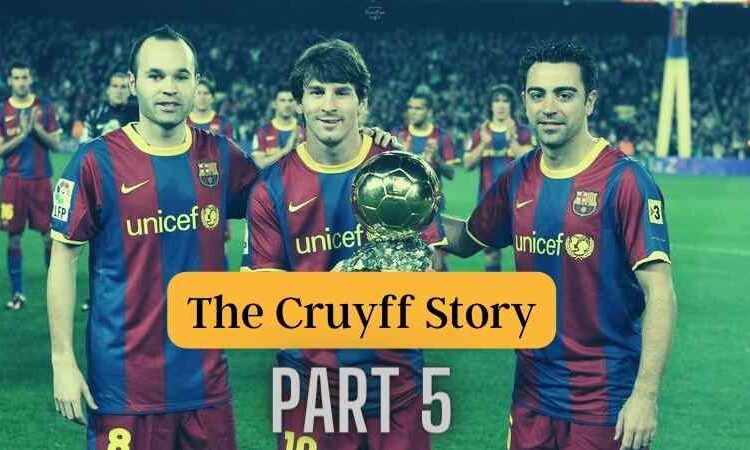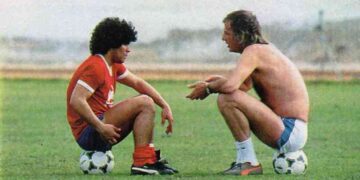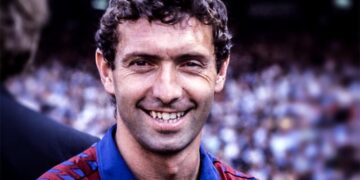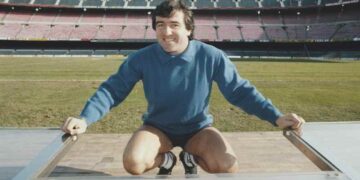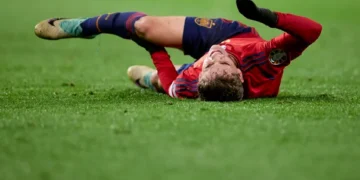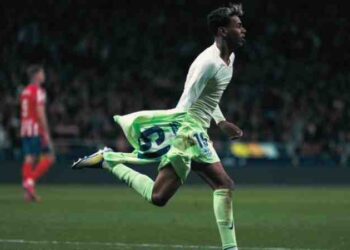The best footbal players are athletes – So this Argentine dribbler was too small to justify an investment. Newell’s Old Boys didn’t think it was worth paying for his treatment with growth hormones. River Plate drew the same conclusion. When Lionel Messi reported for a trial match at Barcelona, he was laughed at. “Is this guy going to play with us? He looks like my little brother’, Gerard Piqué cried.
At his youth club there had been similar doubts. “When you saw him, you thought: This boy can never make it. He is a dwarf, he is too vulnerable, too small,” said youth coach Adrián Coria. “But as soon as he touched the ball, it was clear that this was a phenomenon.”
Yet, even after Messi had let his feet speak, the doubts remained. After a month in Catalonia, still nothing had been signed. Jorge Messi was about to take his son back to Argentina. On which Charly Rexach – Johan Cruyff’s assistant for years – signed Messi with a napkin. A napkin that changed football history.
The fact that Barcelona, of all clubs, did dare to sign the dwarf from Rosario was partly due to Cruyff. When he returned as a coach at the end of the eighties to the club he played for in the seventies, the thought prevailed that football was becoming more and more physical. As with other sports, top players would increasingly become freaks of nature. Winners of the genetic lottery. Giants with enormous running ability who could combine that with some technical skills.
This is Part 5 of #TheCruyffStory Series. It’s recommended to read parts 1, 2, 3 and 4 first.
Barcelona even had a sign on La Masia with the text: Are you coming to offer a youth player who is smaller than 1 meter 80? Then turn around. Cruyff deleted that message. Told everyone who wanted to hear it, that talent was more important than height. Which resulted in a golden era for the club.
Of the breakthrough youth players from the team that dominated global football between 2008 and 2015, apart from the tree-long Gerard Piqué and spaghetti string Sergio Busquets, the two exceptions to the rule, no one met the criterion that was formulated on the board removed by Cruyff. These small ones didn’t just become professional football players against the odds. They formed the core of one of the best teams in the history of football, both in club context (Barcelona) and with the national team (Spain).
Cruyff saw – against the spirit of the times – that football consisted of much more than being strong and fast. As a result, the program that selected on the basis of other criteria left the world amazed.
The one who discovered Pep
Even the coach of the golden age of Barcelona players almost lost to top football. Because no one in the academy dared to draft Pep Guardiola. When Cruyff arrived in 1988, he immediately asked who was the greatest talent. Although the coaches unanimously appointed Guardiola, he did not play in Barcelona B or the Under-19s. The midfielder was as a dispensation player – he was actually too old – active for the Under-17.
‘How is it possible that he is the best of all, but is in the lowest youth team?’, Cruyff asked. They told him that Guardiola could not play in a higher team because of his weak physical constitution. Cruyff replied: “We all grow in life.” He promoted Guardiola – against the wishes of the board – to Barcelona B. To experience that those who are not strong must be smart. Less than four years later, Cruyff won the European Cup I with this player with a weak constitution.
The idea that height wasn’t that important found the origin in his own career. Cruyff was once a youth player with a physical disadvantage. A boy with spindle legs. His nickname was The Shrimp: one and a half meters high and as skinny as a bar. Until just before his debut at the age of seventeen, he could not get a corner in front of the goal. Moreover, due to his growth problems, the dribbler was slow and hopeless in duels. ‘If someone sneezed, I was upside down’, said Cruyff. The later world star was only selected once for the UEFA youth of the KNVB, the Dutch National Football Association. Physically too weak, was always the judgment. Those experiences shaped his thinking. Apparently, a good football player didn’t have to be tall.
Changing the way the club thinks
After some reflection, Cruyff launched Darwin-like theories about physical retardation. That was a disadvantage with great advantages. Because adapting was necessary for survival. ‘Little ones have two advantages: because they are small, they always have to look around on the field, they have to act quickly, otherwise they will be overrun. So they develop their insight very strongly. Secondly, someone who is technically strong, but physically weak, is almost always two-legged.’
In that line of thinking, Cruyff turned around more football wisdom. Players did not have to run more, but less. Quality was not determined by that guy with 25 tricks, but by the one who passes the ball to the right player. The best was the one that always looked around. Football starts iwith the brain.
Cruyff developed more and more theories about the ideal footballer. He came to the conclusion that he was on the ball for a maximum of two to three minutes in a match. So it was mainly about what he did when he was not in possession of the ball. And why was he the best? When he looked at his team mates, Gerrie Mühren had more technique, Johan Neeskens more running ability, Barry Hulshoff more length and John Rep more speed. ‘The only thing I have that someone else doesn’t have is overview, insight. That is to say: I see it a fraction earlier. And because I see it a fraction earlier, you can also put the ball a fraction earlier where it has to go.’
Cruyff was right all along
Unlike other sports, football is not a game that strongly favors players with a certain physicality. Usain Bolt is the best example of this. As a sprinter, he benefited from his long legs. The Jamaican needed only 41 steps to cross the finish line in the 100 meters. His competition needed 45. When Bolt started trying to become a professional football, this advantage disappeared quickly against other aspects of the game.
Every action on the field consists of communicating (tactics), making decisions (game insight) and executing decisions (technique). A small advantage in making decisions – such as a higher top speed – easily outweighs other factors. Because the football rules offer hardly any protection. Moving the starting block, changing lanes and making physical contact with opponents: everything is allowed. Moreover, football is a team sport with eleven players, so the qualities of one can mask the shortcomings of the other.
Although Cruyff fought hard against the convention that top players were getting taller and longer, he seemed to lose the battle around the turn of the millennium. When Guardiola left Barcelona at the age of thirty, only Brescia wanted him. He ended his career in anonymity, with clubs in Qatar and Mexico. “I haven’t changed. My qualities have not disappeared,” Guardiola told The Guardian in an interview in 2004. ‘It’s purely that football is different now. It is played at a higher tempo and is much more physical. The tactics are different now. You have to be good in winning the ball back. If you can also fit, well, that’s a bonus.’
Coach Pep took it to a different level
As a coach, Guardiola corrected these views. He developed a style of play that was based on possession. His selection criteria were therefore different. “My first question is always: can this guy dribble? I only want players who can dribble. Because hiring and fitting well can be learned later. Dribbling is the key.’
For that core skill, being small was suddenly an advantage. Xavi, Andrés Iniesta and Lionel Messi had a lower centre of gravity than many of their opponents, allowing them to change direction more quickly. Which was a big advantage in the ever smaller spaces. Moreover, by standing well in case of ball loss, their biggest shortcoming could be masked. When Messi (1 meter 69), Iniesta (1 meter 70) and Xavi (1 meter 70) together formed the Golden Ball stage in 2010, Cruyff had proved to be right again.
In fact, between 1960 and 2021, the average height of a player in the top five of the Ballon d’Or election has barely increased. Where the average Dutchman has grown about eight centimeters in that time frame due to better nutrition and health care, this appears to be only two centimeters for top football players. Against physical monsters such as Cristiano Ronaldo, Robert Lewandowski and Virgil van Dijk there are still fine-tuned little ones like Luka Modric, Pedri and Lionel Messi.
Bottom line
In most lines, the extremes in length are as far apart as in the normal population. Traditionally, central defenders are a bit bigger, but even there seems to be a change taking place as top teams want to defend further and further away from their own goal. Jurriën Timber, Lisandro Martínez, Jules Koundé and David Alaba are examples of this. Defenses with three men in the center offer extra opportunities for these type of defenders.
FIFA concluded after the 2014 World Cup that the little ones were the ones who laughed last: ‘It is not easy to find another contact sport that remains so accessible to small players.’ We owe this partly to Cruyff’s vendetta. Who worked hard for the little technicians when the lovers of physical football threatened to exclude them.’
Discover more from Barça Buzz
Subscribe to get the latest posts sent to your email.


